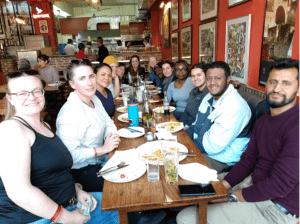The 2023 Winter Amp Travel Team arrived in Nepal on January 4th! The team, comprised of 10 Global STEWARDS fellows and led by Dr. Rianna Murray and Mr. Maurice Rocque, are in Nepal to learn about FEW nexus issues and the local solutions implemented to ensure future food and water security. Follow our daily blog posts here written by the fellows!
Day 1: Wed January 4 – Arrival and sightseeing in Kathmandu
Written by Amanda Siciliano and Jennifer Morash
We kicked off the first day of the trip with a Nepali breakfast at Hotel Imperial. We then toured the holy Pashupatinath Temple, and found a friendly guide named Bikram to lead the way. STEWARDS learned about typical Hindu and Buddhist cremation ceremonies along the Bagmati river, and toured the monuments and cultural heritage site. Folks from all around the world (and monkeys too!) can be found walking the area. As for the architecture, the three most popular (and beautiful!) styles of temples throughout the area include pagoda, stupa, and shikhara.
Overall, the Pashupatinath Temple is a holy area for Buddhists and Hindus alike. One trip to this sacred land will bring good fortune and well-being for visitors. Holy men, typically dressed in a variety of different colors but pictured here in orange cloth, are thought to bring blessings of good luck and prosperity. STEWARDS then enjoyed a delicious lunch at Vedic food, where we got to try Veg Khona and milk/black coffee dishes.
After lunch, a small group traversed the busy streets of Kathmandu to visit Boudhanath, a sacred site for Buddhists. The Boudhanath stupa (temple), one of the world’s largest circular structures, holds the remains of Buddha. It dates back to 600 AD when it was built by a Tibetan king. In 1979, it was listed as a UNESCO world heritage site. The stupa is surrounded by prayer wheels and is adorned in gold. Buddhist pilgrims from around the world visit the temple and walk clockwise around it 3 or more times chanting ‘Om Mani Padme Hum’.
The food, energy, water nexus was on the minds of our group all day as we contemplated the health of the sacred waters and dodged dangling power lines.
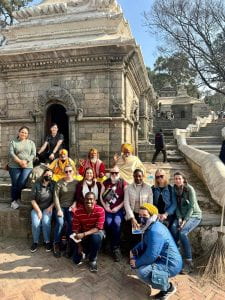



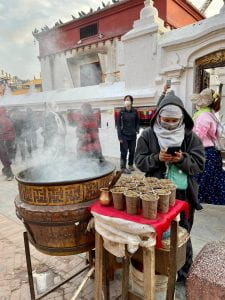

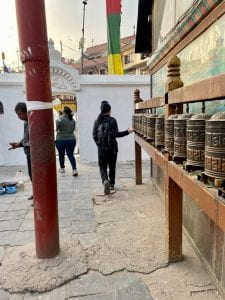
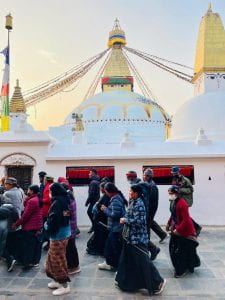
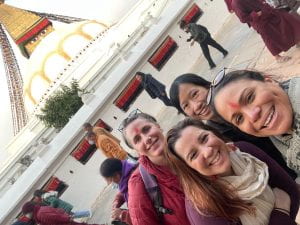
Day 2: Wed January 5 – Visit to Tribhuvan University, Bhaktapur, and arrival at Sanskriti farms
Written by Aimee Malzhan
Nepal’s scientific and cultural heritage
Today we had a full day visiting Tribhuvan University, the cultural center of Bhaktapur, and made the drive up into the mountains to Sanskriti farms.
Tribuhuvan University (TU) is the oldest university in Nepal and covers a large amount of land a short distance from the busy downtown of Kathmandu. The visit was set up by Sarbesh Das Dangol, a faculty member working on CRISPR plant genome engineering. I was especially looking forward to this visit because this was the topic of my PhD thesis. In the past few months, I’ve graduated and started working at Boyce Thompson Institute (but once a Steward, always a Steward!) where I was connected to Sarbesh. Sarbesh, along with some of the faculty and students from the Department of Biotechnology, met us outside with a warm welcome and invited us into the building for a tour. The labs at TU aren’t covered in the clutter of chemical bottles and pipettes I’m used to seeing, but there is a whiteboard with a familiar description-it’s a workflow of the methods I used in my thesis!
Faculty and students led us through the labs and described their research, which ranges from COVID diagnostics, dengue fever, to biogas and fungal diseases of moths. After the tour, we sat down to tea and cookies and talked about some of the successes and challenges of research at TU.
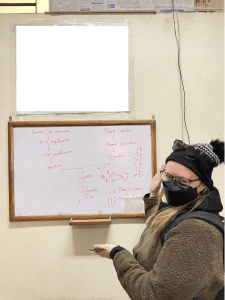
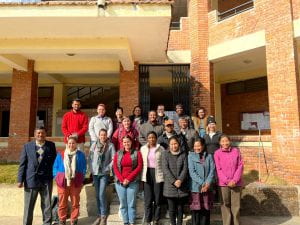
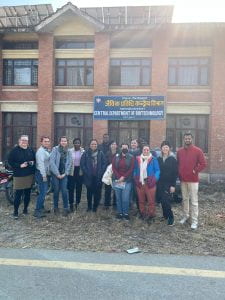
We left the oldest Nepalese university for a much older site- the city of Bhaktapur. Bhaktapur is a cultural center with museums, an art school, temples, and a palace dating back to the 5th century. Intricate woodwork decorates the historic buildings with flowers and figures of Hindu deities, and the streets are lined with shops selling singing bowls, wooden and metal crafts, and colorful pashmina and yak wool scarves. The winding streets open into the square where the tallest temple is across from a palace. Inside Bhaktapur is an art school where students perfect their skills drawing mandalas in detail best seen under a magnifying glass. Color and artistry are the defining features of Bhaktapur.
Nepal has a rich cultural heritage and researchers working on scientific advancements that will serve the country. Connections and collaboration are an important part of supporting Nepal’s scientific community, and the hope is that more relationships will develop between universities.
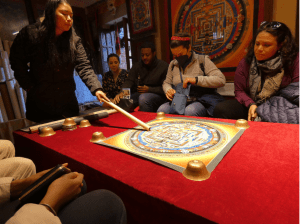
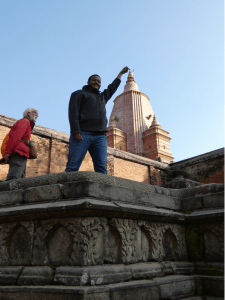
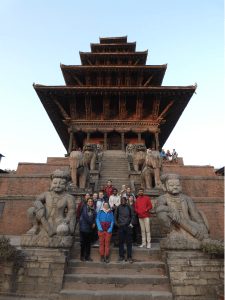
Day 3: Friday January 6 – First day at Sanskriti Farms
Written by Amin Elamin
We woke up on our first morning on the farm to the chilly highland air, many of us before sunrise, to watch the sun rise behind the Himalayan mountain range. As we waited for the 6:55am sunrise show to begin, we found ourselves surround by many of the indigenous bird of the region. Luckily, we were told that the view of the mountain was clear, which it had not been the past several days, and while Everest was not visible the view was quite spectacular.
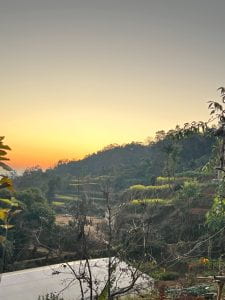

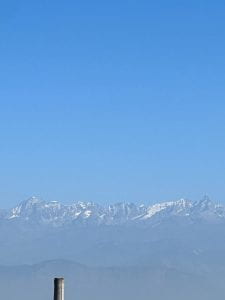
After enjoying the view, with many pictures and “ooohs and aahs” from the audience, we slowly came to our senses and the cold weather sensations re-emerged. Our hosts at the home stay provided us with warm herbal tea and a started a fire, which we sat around and enjoyed some lovely conversation with the farm manager, Shree, and his family. We were able to talk briefly about the farm, life in Nepal, and some development projects in the area.
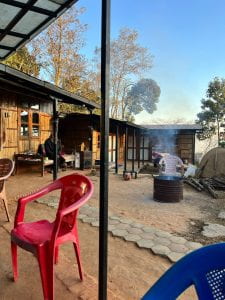

Soon after and once the whole group was awake we had a warm breakfast consisting of rotī, eggs, aloo curry, and apples. We finished our breakfast with warm milk tea. After eating, we had a presentation from our hosts about the farms history, its mission, vision and goals. It helped to situate the project in FEW Nexus, and local rural development. Afterwards, we had our first training session titled, “Tree Plantation Session” in which we learned about the process and science of planting and transplanting trees that were both grafted and those from seeds. We talked about important considerations throughout the process and challenges.
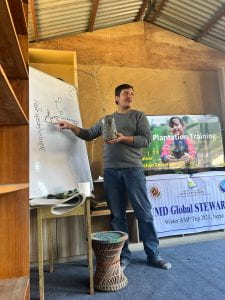
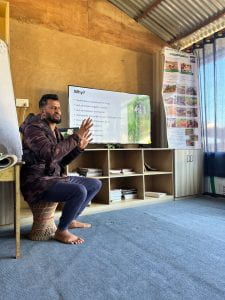
Then it came to put theory to practice through a tree planting activity in which we planted a nectarine tree on the farm. It was truly a group effort, to which we were told that this was a one person job. After several hours of lectures and tree planting, we were welcomed for lunch.
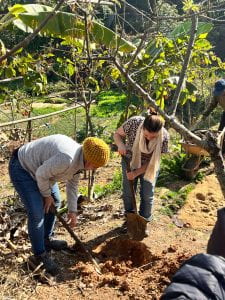

Finally, we had the opportunity after lunch to meet our home tour guide for the following days and have a Q&A/conversation with the biotechnologist who led the planting training session on this experience and expertise. With this we ended our day, with many of us still tired and jet lagged. Until tomorrow!


Day 4: Saturday January 7 – Tour of Mathurapati village
Written by Nicole Sieck
Today we walked to the local village, Mathurapati, and were given a tour by Shree. He introduced us to many of the FEW nexus issues the village is experiencing. First, we walked down to the local well, which is fed by a natural spring. Villagers walk down to the spring to bring fresh water back to their homes for drinking, cleaning, and for the animals. People, usually the women, carry 20-30 liters at a time.
We then saw one of the first water collection ponds Shree built in 2012, which was a trial for proof of concept. Shree told us that many villagers were skeptical it would work and felt that the space could be better used to grow more food. When the dry season came, however, Shree’s family were the ones with water. He told us neighbors cut the plastic liner, but instead of getting angry, he saw this as evidence of acceptance and need in the community. Having the ponds ensures that families can store precious rainwater collected during the monsoon season (June – September) and use it to irrigate their crops and feed their animals, rather than collecting water from the local spring and hauling it back to their homes for this purpose.
Walking through the village, we also saw how corn, grown by virtually everyone in the village, is stored after harvest. Corn is typically stored elevated, as rats are a big problem in the area. We also got to see a traditional cooking stove, livestock (cattle, buffalo, goats, and chickens), and farms growing tomatoes, citrus, avocado, squash, leafy greens, and mustard.
Finally, we toured the local school, where Shree’s father is a teacher. He showed us the school’s underground tank, built about 5 years ago, which provides water to the school. The school has also been working with the Rotary Club, which has assisted the school in upgrading the restrooms to improve student hygiene.
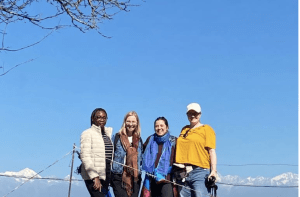
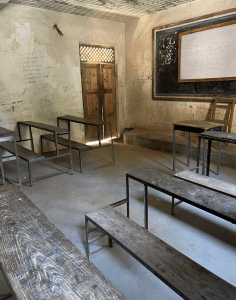
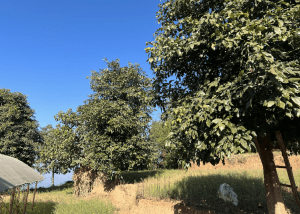
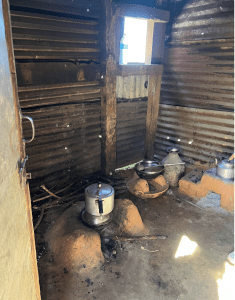
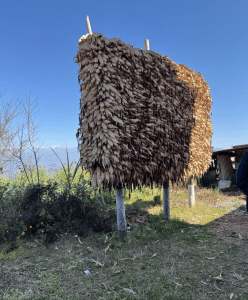

Day 5: Sunday January 8 – Hike to Namobuddha & Thrangu Tashi Yangtse Monastery Video by Ibiyinka Amokeodo
Day 6: Monday January 9 – Training on sustainable and organic farming practices at Sanskriti farms – biochar, rainwater harvesting, biogas, and diversity farming Written by Stephanie Chia
We had a very productive day at Shree’s farm doing organic farming training, biochar workshop, farm tour, watched a documentary, cooked our breakfast and lunch, and enjoyed our last night here.
Our trainer Roshan introduced an organic farming technique, in which we dug a 2 ft deep rectangle hole, and put four layers of green and brown biomass, each covered with a layer of soil. This kind of nutritious plantation can generate 21 kg of biomass and can last for four years. We planted green onions on this new plantation in Shree’s farm. They can be harvested in three months and we are going to follow up on them!
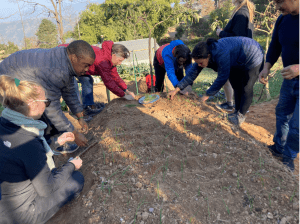
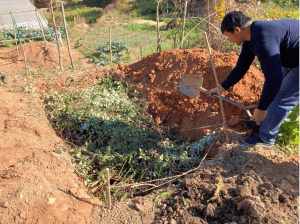
Shree then introduced the making of biochar, which can be used for soil amendment, water retention, animal feed, and a potential carbon sink. We had a deep discussion of the function of biochar in the soil with inputs from Global STEWARDS in plant science, civil engineering, and material science. Later on, Shree showed us how to make biochar with his device in the farm.

Every Global STEWARDS received a certification by Shree and Roshan for completing all the training activities in the farm. Before dark, Shree gave us a farm tour, in which we learned about the beehives, rainwater retention ponds, the biogas system, and the diversity of plants in the farm. It was truly amazing how everything in the farm is being used and that nothing goes into waste.
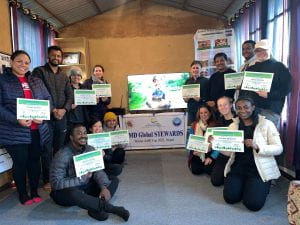
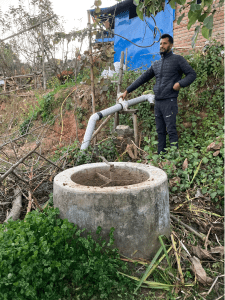
Today we also watched a three episode documentary After Shock: Everest and the Nepal Earthquake, which tells stories of the 2015 earthquake striking Nepal. After the documentary we also heard from Shree about his family’s memory of the earthquake and how the earthquake changed a lot of people’s lives here in Nepal.
Last but not least, we had a wonderful day with three perfect meals. Shree’s wife Rupa and Shree’s mom taught us to make roti. Ibi made us nutritious scrambled eggs with vegetables. Natalie made fried chickpea balls which were delicious and lots of fun to eat. Finally, Rupa made us the best rice pudding ever for our last dinner here on the farm. We enjoyed the starry night with the orange full moon rising from the Himalayas.
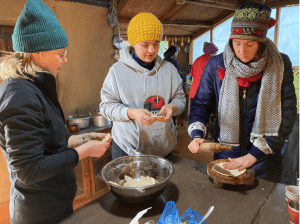
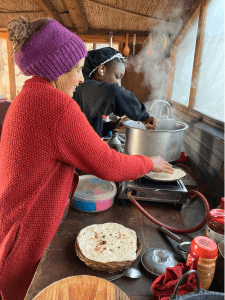
Day 7: Tuesday January 10th – Completing the tour of Sanskriti Farms, saying our goodbyes, visiting Namobuddha Municipality, and travel to Dhulikhel. Written by Michele Morgado
Another morning dawned at the farm and it was hard to believe that our visit to Phoolbari Homestay was coming to an end. Before enjoying our final breakfast prepared by Shree’s wonderful family, Shree retrieved the biochar that was produced the night before. Due to the design of the chamber, the biochar had to burn over a longer period of time and ended up producing large chunks instead of smaller pieces. Shree told us that the biochar would likely be used to improve the soil quality in his farm and he would also test it as a water filter to remove potentially harmful E. coli bacteria.
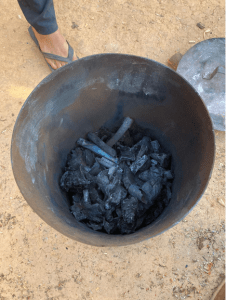
After we examined the biochar, Shree wanted to show us how the solar dryer (cooker) worked. He carefully placed a water kettle on a frame and then directed the solar dish towards the sun and we waited. Unfortunately, this particular morning was cloudier than usual and heating the water would likely take a fairly long time. The dish also has to be moved frequently to follow the path of the sun; when it is very sunny, Shree mentioned that the water could reach a boiling point in a matter of minutes. This morning though, we decided to continue with our tour and come back to it later.
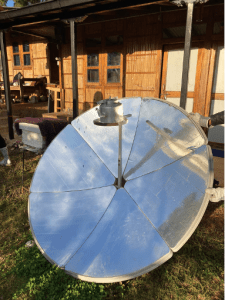
We moved onto the smallest of the nurseries, where Shree keeps a wide variety of citrus plants over the cooler winter months. Here we observed small trifoliate plants that are used for grafting of the various citrus species. We learned that these thorny plants provide a more solid and sturdy base that ensures a better survival rate for the citrus plants. As we walked to the largest of the nurseries, Shree pointed out a metal cutting device that they use to break up the hard corn husks that are then mixed with rice millet and allowed to decompose in the warm sun. This process produces a rich feed for their cattle as well as a valuable potting mix.
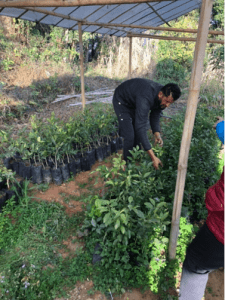
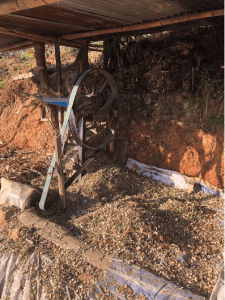
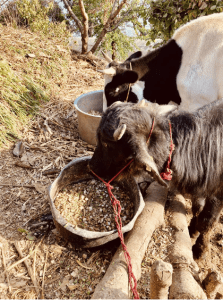
At last we visited the larger enclosed nursery where the more temperature sensitive fruit and nut tree plants are kept over the winter months. Some of these species included the plum, cherry, apricot, nectarine fruit trees, and various nut trees. These small trees will eventually be sold or donated to local farmers and organizations. As we walked back to the outside dining area to enjoy our last meal at the farm, Shree told us how the basil plants that we saw in large numbers around the farm were very important to provide bees with pollen during the winter months, when other flowering plants can be more scarce.

Our final breakfast at the farm was definitely bitter sweet. We enjoyed a delicious pasta dish with freshly collected vegetables, served with an egg fry and fresh apples on the side. We thanked our wonderful hosts for their warm hospitality and we were blessed with a placement of tikka on our foreheads (a mix of yellow and red colored spices) for safe travel, and offered a beautiful flower arrangement as a token of their appreciation for our visit…and then we were off to visit Namobuddha municipality.
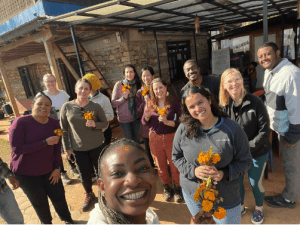
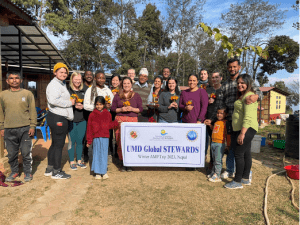
At the Namobuddha municipality, roughly a 45 min drive from the farm, we had a chance to meet with various local leaders, including the mayor, and those responsible for the environmental, educational, and financial sectors. We learned that their main focus is to manage the waste, mainly from agriculture, and to be a fully organic municipality (11 wards must be certified as organic) in a few short years. Challenges remain in terms of the acceptance of some of these organic practices, often more time consuming and/or expensive, by local farmers. In terms of strategies, they use a combination of educational awareness and direct engagement with local farming communities. They also bring expert training to them, like that provided by rotary members such as Shree Dhital. Our discussion panel concluded and we moved outside to be part of a symbolic planting of 20 fruit and nut tree plants donated by Sanskriti farms. We thanked the Namobuddha municipality leaders for their time and efforts and left for the next destination on our journey, Dhulikhel.
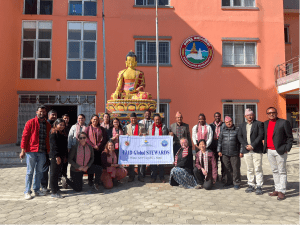

Day 8: Wednesday January 11th – Visit to Dhulikhel Hospital, Kathmandu University Written by Natalie Crnosija
We spent the day at Dhulikhel Hospital, a Kathmandu University hospital. We met Ruby Shreshta, an epidemiologist, and learned about the history of the hospital. Founded 25 years ago by Dr. Ram M. Shrestha, this public hospital’s guiding philosophy that “poor people need medical care” is enacted by giving access to care to those most in need. Registration for care services can be secured for 100 Nepali rupees, which is less than $1US. We began the visit by watching an inspiring video of Dr. Ram Shrestha’s vision for the hospital, which can be viewed here: https://youtu.be/yR0je4Uu4-4

This hospital is part of a network that includes 18 outreach centers located throughout Nepal that serve rural communities. The activities of the Dhulikhel Hospital network extend beyond the provision of clinical services, also facilitating microfinancing opportunities for local women and local infrastructure construction, like bridges, so people can physically get to the outreach centers more easily. (These philanthropic activities are funded through various NGOs.)
After surveying the massive medical campus, we toured the hospital with Nishan, a research coordinator at the hospital, visiting the Department of Clinical Biochemistry, passing by patients awaiting treatment. He took us to the Genomic Research Lab, where the status of the lab’s scholarly papers were listed on a large white board.
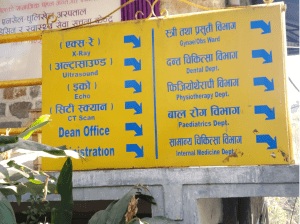

After being treated to lunch at the hospital canteen, we returned to the conference room where we had learned about the hospital’s history to learn about the history of Nepal from Mike Gill, a former Peace Corp volunteer who first came to Nepal in the 1960’s. Next, Dr. Binaya, an associate professor of Mechanical Engineering at the university, presented his research focused on air pollution exposure associated with indoor cooking using solid fuel sources.
We then learned more about the domains of health-centric research supported by the university from Nishan, which include vaccine trials; health systems, health behavior and prevention; maternal and child health; mental health infectious disease surveillance; and non-communicable diseases.
Our visit concluded and we descended the hill back to our hotel, passing people in scrubs on our way…
Day 9: Thursday January 12th – Visit to Travel to Dhulikhel Hospital Outreach Centers in Bahunipati and Manekharka Written by Natalie Crnosija
To continue to learn about the Dhulikhel Hospital (DH) system and how it serves communities, we hit the road! We left Dhulikhel for Manekharka by way of Bahunipati in a trio of land cruisers. When we arrived at Bahunipati’s DH Outreach Center, we were struck by the beauty of the river that flowed nearby. We were greeted at the outreach center by Dr. Amir, who gave us a tour of the center’s medical facilities, which include a women’s health exam room, x-ray facility, physical therapy space and a small surgical office for minor surgeries.
After being treated to milk tea on the hospital’s terrace roof, we set out for Manekharka. Traveling for over two hours over a long, windy, steep, narrow and bumpy (!) roads, we arrived at the DH Outreach Center.
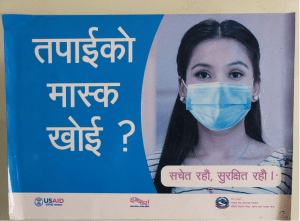

Like its counterpart in Bahunipanti, this hospital serves the local community by providing primary care. (When we arrived, a patient was meeting with a DH staffer.)
We then went to our homestay to deposit our bags and walked along a rock-cobbled road, perched on the side of a hill with crops sprouting from terraced plots; on our return to the hospital, we visited a home to inspect a kitchen to better understand how cooking with solid fuels in enclosed areas occurs actually looks, having listened to Dr. Binaya’s presentation the day before.
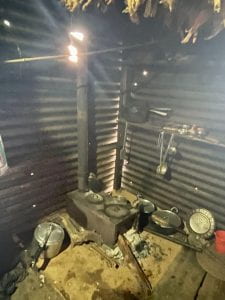
When we continued onto hospital, we encountered Santamayabica, a local woman who received microfinancinging through DH’s philanthropic partners to buy some land, an opportunity that can be life-changing for some.
As we approached the hospital to have dinner, the sun set on the town.
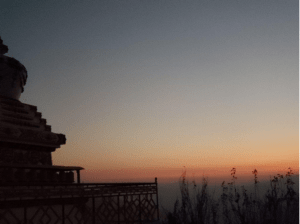
Day 9 ended with Nigerian tunes provided by Ibi and fermented millet, a traditional spirit shared by mountain villagers.

Day 10: Friday January 13th – Morning in Manekharka and travel back to Dhulikhel Written by Jennifer Morash and Michele Morgado
Our cheerful evening on Thursday night didn’t prevent some early risers from seeing spectacular sunrise views the following morning. At 6:00 am, Global STEWARDS joined our outreach hosts for a 45-minute drive higher up into the breathtaking mountains. Our destination included a Buddhist shrine and unobstructed views of the sunrise on the jagged Himalayas. The temple was adorned with the familiar sights of prayer flags but they seemed more vibrant in the chilly mountain air. The serenity of the moment was jostled when our attention was brought to the concerns of the Nepali people. Ruby explained that the very spot where we stood would have been covered in snow this time of year 20 years ago. She expounded that the beautiful white tops used to extend further down the mountains before us. The worry in her voice for her people who depend on glacier fed streams and tourism was felt by each of us as she described the urgent need for policy to address climate change. Perhaps our prayers for Ruby, Nepal, and ourselves were better heard from such a sacred place.
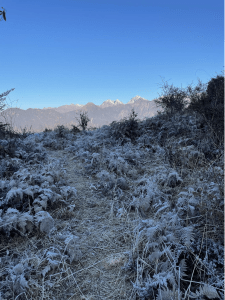


After breakfast we had the opportunity to learn more about the KOICA ERCN Project. This is an important collaborative effort that includes the Korean government and Nepal’s Ministry of Health. This effort is helping local farmers living in more remote rural communities learn about organic farming practices and allowing them to more easily sell their excess produce. Part of this work includes having demo farms, training farmers, and education at schools. They also have a technical consultant that will travel to the communities and teach farmers how to use pesticides, and apply organic farming methods. Another significant part of this work is creating specific sites for farmers to sell their produce. In this case, they will have one large collection vehicle that will transport the farmer’s produce, instead of each farmer having to travel once a week to sell it. It will help farmers with transportation costs and the stress of driving back and forth through rudimentary roads. The plan is to have three sites up and running within a year’s time.

After saying our goodbyes, we began our return trip to Dhulikhel. The scenery was breathtaking but the treacherous roads were a stark reminder of the difficulties faced by farmers living in these remote villages.

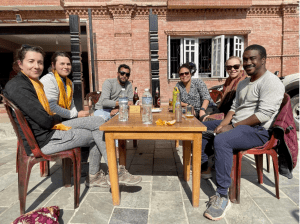
Day 11: Jan 14th – 1000 Steps Hike and rest day (Written by Ibiyinka Amokeodo)
Day 12: Jan 15th – Driving back to Kathmandu and visiting a plant tissue culture lab and cultural sites along the way (Written by Jennifer Morash)
As our time in the mountains came to an end, we gathered for the requisite group photo in front of the Dhulikhel Lodge Resort. It was hard to say goodbye to the mountain scenery, especially since leaving marked the beginning of the long journey home. Nevertheless, Shree planned another busy day of sightseeing so that no time was wasted in the foreign land. The first stop was Kathmandu University (KU), Shree’s alma mater. Fittingly, a statue of Saraswati, the goddess of education, greeted us. Even though the university was closed for the holiday, we sensed the familiarity of a college campus. It reminded us of the busy semester ahead, which many of us were happy to put off for a few more days.
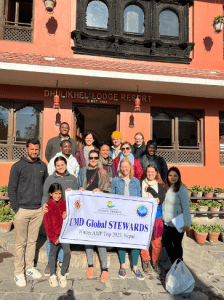
Next, was a tour of Chandeshwari Temple in Banepa. The temple was built in the 17th century and depicts a gorgeous painting of lord Bhairava on one of its walls. The painting along with the temple offerings exemplify how color is used throughout Nepal to celebrate. The walk through Banepa presented the opportunity to consider differences in food and water access for Nepalis and Americans. Perhaps most obvious is the decentralized nature of access. For example, in Nepal fresh food is brought directly to market for sale instead of being collected and sold by large grocery chains. In terms of water access, indoor plumbing is not ubiquitous. This means that water must be collected by countless Nepalis citizens and dealing with wastewater is a hardship endured by all.

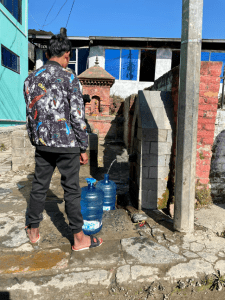
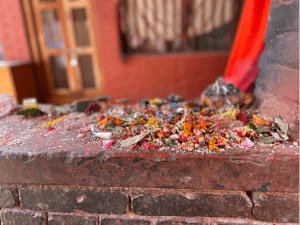
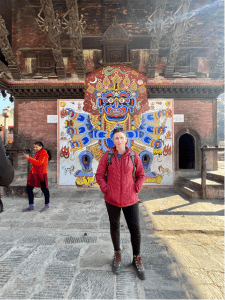
Jennifer in front of the detailed wood carvings and lord Bhairava mural at Chandeshwari Temple
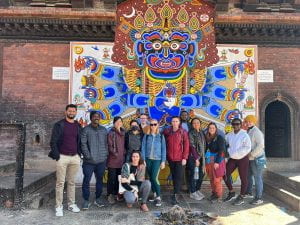
Global STEWARDS with Shree at the Chandeshwari templeNext on the agenda, we rejoined Roshan for a tour of a lab that propagates potatoes through tissue culture. Here, the food-energy nexus was front and center. Tissue culture perpetuates disease resistance. However, it is expensive due to high energy costs. Propagation by this method requires a highly controlled environment, which includes the need for lighting 18 hours a day, a constant cool temperature, and use of an autoclave to ensure sterilization. A lab such as Roshan’s costs around 500,000 Nepali rupees (approx. $3,850 USD) to establish. Plant sales are used to cover yearly costs but hard-to-win grants are needed to pay for startup costs.
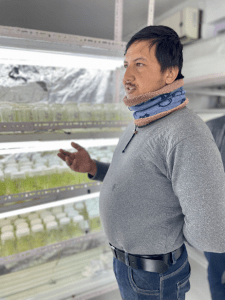
Next, Shree arranged for tea and a conversation with Dr. Bim Prasad Shrestha, Associate Professor in the Mechanical Engineering Department of Kathmandu University, at the swanky Dwarika’s Hotel. Dr. Shrestha was actually Shree’s advisor while he was at KU pursuing his masters degree in mechanical engineering. Dr. Shrestha has been involved in countless research collaborations immersed in the FEW nexus, including a partnership with MIT students to build biomass-fueled cookstoves that reduce smoke exposure. Dr. Dr. Shrestha highlighted the advantages of Nepal’s cultural history and modern government, which make Nepal an ideal country for diplomatic relationships. Given the nation’s willingness to work with others as well as its abundant water resources and fertile land, Nepal is uniquely advantaged to prosper as long as projects to improve the country’s infrastructure continue. To ensure this, global partnerships are necessary. Therefore, we were encouraged to return home to tell Nepal’s story and to act as ambassadors. This request will not go unanswered by the humbled and grateful UMD Global STEWARDS.

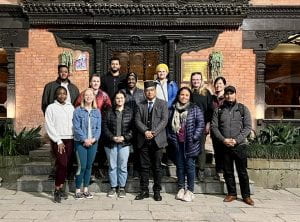
Finally, after a long day of sightseeing and learning, the group headed out for dinner to celebrate the birthdays of Rupa (Shree’s wife) and Maurice. It was truly a night to remember with cake and dancing to mark the joyous occasion. It was also our last night in Nepal, and it was one that we will never forget!

Day 13: Jan 16th – Visit to the NGO ENPHO in Kathmandu and shopping in Thamel (Written by Erica Forgione)
Our last day in Nepal we visited staff members at ENPHO (Environmental & Public Health Organization), a non-profit organization based in Kathmandu but serving all of Nepal. Rajendra Shrestha, the Program Director of ENPHO, gave a short overview of the mission, vision, and current work, followed by discussion. Established in 1990, ENPHO is a service-oriented scientific organization with a vision to create eco-societies and a mission to “develop, demonstrate, and disseminate innovative technologies and systems to enable societies to become healthy and environmentally friendly.” At the core of all of ENPHO’s work is water, sanitation, and hygiene, on which they assert all other societal benefits hinge.
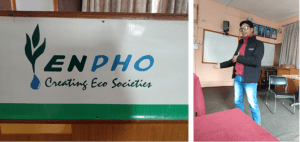

ENPHO provides laboratory spaces in which new technologies are developed, and tests those new technologies through research and development efforts, and finally provides knowledge dissemination through communication campaigns and dedicated staff members. Clean water and sanitation are major challenges to public and environmental health throughout Nepal, leading ENPHO to work on easy-to-use and sustainable technologies such as household water filtration systems, constructed wetlands for wastewater treatment, and fecal sludge composting and biogas systems. Through continued funding over the last 32 years, ENPHO has completed projects in all 77 districts of Nepal directly benefiting more than 4 million people. (Nepal’s current population is 30 million.)
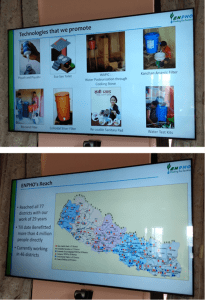
One notable success is ENPHO-developed water testing kits that can be distributed to households. A user can simply place a few drops of liquid from the provided container into a bottle of water, shake, and wait 30 minutes. If the water turns black, this indicates bacterial contamination and warns the potential drinker that it is unsafe. ENPHO also produces cheap chlorine drops to disinfect drinking water and reusable sanitary pads for girls. ENPHO facilities include laboratory services, training offices, technical support, and community development. We were able to tour the water testing lab after the presentation a couple floors down.
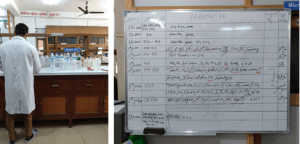
Anyone is able to send water samples to ENPHO to be tested for contaminants and for potability (safe drinking). While bacterial contamination is a major issue, which is tested in the lab through total coliform and E. Coli, heavy metals such as arsenic may also be an issue in some source waters and are also tested for in the laboratory. The white board of slated samples to be tested on the wall looks very similar to the ones in our water research laboratories back home.
After our time touring ENPHO facilities the group headed to Thamel, the number one hotspot for tourists and shopping in Kathmandu, for a final shopping run and bustling city experience. Many of us noticed (and purchased) items on display with intricate embroidery, including wool scarves and blankets, rugs, pillow covers, and pouches. The intricacy in these designs echoed that which we saw in the mandalas and other traditional thangka paintings we viewed at the art school in Bhaktapur.

It was bittersweet as we enjoyed our last group meal together with Shree Krishna Dhital at a pizza and ice cream parlor in Thamel named “Fire and Ice” since soon we would also have to say goodbye to our guide and new friend who joined us for most of the trip.
We felt so welcomed on our trip by Shree and his family and gathered so much valuable knowledge and fellowship with biotechnology expert Roshan Shrestha, the faculty and students at Tribhuvan University, Namobuddha municipality leaders, Kathmandu University members, Ruby Shrestha and the other Dhulikhel hospital and outreach center staff, as well as all the hotel staff, drivers, and neighbors along the way. Each of us will have to wait and see if we can find a way back to Nepal in the future, but meanwhile can rely on the bonds that were made on this trip with our Nepali colleagues to continue working on global FEW nexus issues together.
